1.15: Religion
- Last updated
- Save as PDF
- Page ID
- 53284
Religion is a unified system of beliefs, rituals, and practices that typically involve a broader community of believers who share common definitions of the sacred and the profane. Sacred is the supernatural, divine, awe inspiring, and spiritually significant aspects of our existence. Profane is that which is part of the regular everyday life experience. The definitions originated from Durkheim's studies of religion (see 1947 The Elementary Forms of Religious Life, Glencoe Press reprint of 1912). For you, religion might be a personal definition of how you feel about your place in the universe. It may also reflect how you understand categories of people who share a common system of beliefs that differ from your own (Jews, Muslims, Christians, etc.).
For sociologists, religion is typically studied in two typically approaches: first, a cultural approach that evaluates the religious aspects of the culture shared by followers of a certain religion; second, a theoretical approach to religion including its symbols, functions, exchange-based interactions, and power issues. Religion has always been an important issue at both levels of society: personal and larger social. Figure 1 shows a pie chart of the CIA's 2007 estimate of the world's composition of religious followers. By far, Muslims collectively comprise the largest single religious belief system in the world in 2007. Over the last century birthrates among Muslims have remained high. By sheer numbers alone, a high birthrate among an estimated 1,300,000,000 people makes birth become a significant factor in the Muslim world growth rate. A less common factor is that in many Muslim nations polygamy continues to be the norm with 1-4 wives being acceptable.
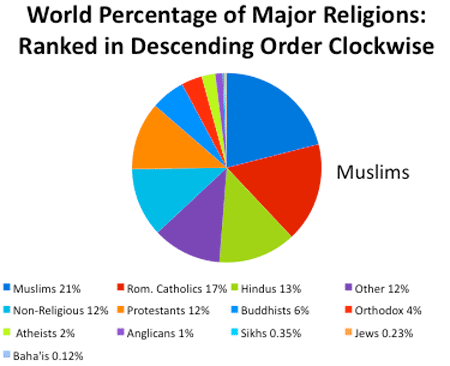
*Taken from Internet on 22 May, 2008 from https://www.cia.gov/library/publicat...k/geos/xx.html
Next is the Roman Catholic Church which has strong membership in Western Europe, Latin America, the United States and other Countries and regions. Hindus which are primarily located in India come in a close third. Jews which are daily discussed in the news because of international issues pertaining to Israel are ranked 12th most common in the world.
The United State's Religions
Figure 2 shows the CIA estimated US religions for 2007. The collective category of US Protestants is the largest collection of religious belief systems. These include Baptists, Lutherans, Anglicans, and various non-Catholic and non-Orthodox Christian denominations. Second in percentage is the Roman Catholic Church. In contrast to the Protestant classification which is comprised of many diverse denominations, the Roman Catholic Christian Church is comprised of only one denomination headquartered in Rome, Italy.
The Roman Catholic population in the US has grown for two primary reasons: first, Roman Catholics continue to have higher birthrates than others (yet about the same for Mormons and Catholics); and second, many of our US immigrants since the 1980s come from Mexico and bring their Catholicism with them to the US. Also from the CIA data is the fact that about 12 percent were unaffiliated, 4 percent reported none, and 3 percent chose not to specify their religion. After that, Mormons were next with nearly 2 percent. Mormons have a very high birthrate and a strong force of proselytizing missionaries throughout the US and the World.
Figure 2. 2007 Estimation of Percentage of United States Religions*
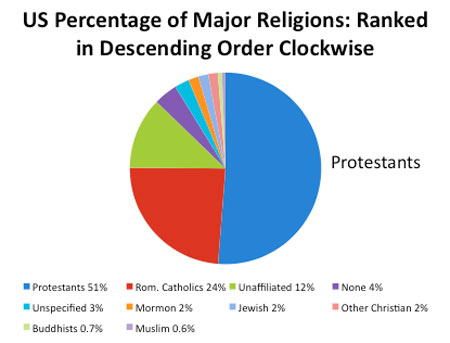
*Taken from Internet on 26 March 2007 from www.cia.gov/library/publicat...elds/2122.html
The history of religions in the world and US cannot be overstated in terms of the religiously-motivated treatment and mistreatment of other human beings in the name of religion. Given the peaceful nature of most of the major religions it is paradoxical to have so many: religiously-based wars, genocides, population transfers, conquest, and other forms of large-scale aggression which have transpired throughout history. In the Race and Minority Chapter we learned about prejudice and the goal of finding common ground in building bridges and overcoming prejudices. With religions this is particularly difficult to apply.
Many of us believe very deeply in our religious convictions. We change and alter our lifestyles and desires because we believe that our hope, salvation, or existence will be made better because of our sacrifices. It's understandable that we are deeply devoted and passionate. But, we also tend to believe that we belong to the exclusively right or correct faith and that all others are mistaken and perhaps going to hell. Some religious fanatics believe so strongly in the damnation of non-believers that they feel justified in killing others as an act of so called, "saving other people from themselves." This explains in part the rationale of the religiously-based conflicts in our current and historical experiences.
Religious Tolerance
Believe it or not, we don't have to all believe in the same way and people who believe differently from you probably do so as passionately as you do with your beliefs. Finding common ground takes more effort, but sustains the process of open-minded, non-prejudiced treatment of others of different religions. Figure 3 shows a photograph of one of my favorite books. Written by Jeffrey Moses, "Oneness: Great Principles Shared By All Religions" and forwarded by Mother Theresa, this is truly a work of bridge-building between believers. In it Mr. Moses describes common beliefs and values which are articulated in the core doctrines and scriptures of many of the world and US religions. "Honor thy father and mother, be good to those around you, it is better to give than receive, and respect the elderly in your life" are just a few examples of common teachings from many diverse religions found in the book.
Figure 3. A "Common Ground" Approach to Other Religions by Jeffrey Moses
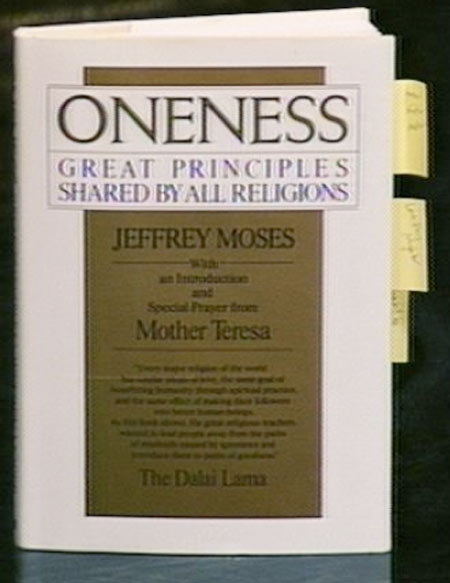
To take such an open-minded stance requires a concerted effort on our part. To be able to feel secure enough in our own beliefs to find acceptance in the beliefs others have takes devotion to our own faith and deep caring about the quality of the human experience in our many relationships. We mistakenly believe that we have strength in commonality when often there's just as much strength found in mutually-respected tolerance of different people who respect and honor one another..
Most people from most of the world's and US's religions share most beliefs in common. It's true, but we more often define ourselves based on differences not similarities. Most of us could peacefully live as next-door neighbors and peacefully co-exist. In fact, the more you talk to one another about your beliefs and the more you agree to accept one another and respect one another's free choice, the more understanding and tolerant you'll become. For example, there's a category of religions in the world called the Abrahamic Religions are those religions which trace their religious ancestry back through "Father" Abraham. Look at figure 4 below:
Figure 4. The Genealogy of the World's Abrahamic Religions: Islam, Judaism, and Christianity
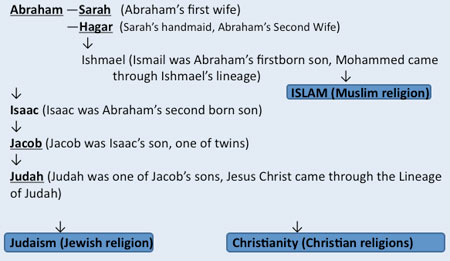
© 2009 Ron J. Hammond, Ph.D.
Abraham had a wife named Sarah who could not get pregnant. She gave Abraham her handmaid, named Hagar, as a second wife. Hagar had Abraham's firstborn son, Ishmael. Ishmael and Hagar ended up in the wilderness and were miraculously preserved from exposure, dehydration, and starvation. Eventually, Ishmael would father 12 princes as his sons. From one of his sons, Mohammed was born, and with him, Islam or the Muslim religion.
Abraham eventually fathered a child with Sarah resulting in the birth of Isaac. Isaac fathered Jacob and Jacob fathered sons, including Judah. From the lineage of Judah came the Jewish religion and eventually Jesus Christ was born a Jew and began Christianity in all its forms. All three Abrahamic Religions combined account for about 55 percent or 3,685,000,000 people. Father Abraham was promised by God that his descendants would eventually inherit a piece of land called Canaan which had about the same land mass as New Jersey and is called Israel in our day. Christians, Muslims, and Jews have battled and argued over this holy land for centuries and do to this day. I often tell my students that the prophecy stated that Abrahams descendants would inherit the land, not get along together once they did.
Another major genealogical origin of world religions is called Indian Religions are those which originated from the Sub-Asian continent of India. Though the record of these religious origins is a bit more vague than found with the Abrahamic religions, Hinduism, Buddhism, Sikhism, and Jainism are major world religions which represent about 1,300,000,000 people today.
There are a classification of religions that sociologists use to distinguish them based on beliefs and rituals. Simple Supernaturalism has no gods, but focuses on human & non-human supernatural forces which influences us for better or worse. Animism also has no gods, but focuses on good or evil spirits which inhabit animals, rocks and/or people and animals (Simple supernaturalism and Animism underlie Japanese Animism plot structure and themes).
Theistic Religions have divine beings which are Gods. There are three Monotheistic Religions. Monotheistic Religions are religions that have one single all powerful God: Islam, Judaism, and Christianity.
Polytheistic refers to religions with multiple Gods such as Hinduism. About 2/3rds of all people of the world worship in a theistic manner.
Abstract Ideals refers to religions that focus on sacred principles and thoughts which guide our lives and typically have no divine beings in charge of the world and universe. Buddhism is an example of an abstract ideal religion.
The Functions of Religion
Let's now talk a bit about the functional aspects of religion in the larger social picture. If you remember from our chapter on the Sociological Imagination, religion is one of the 7 social institutions in society (media, technology, government, family, economy, and education are the others). For decades sociologists have studied the functional aspects of religion as a social institution. It is safe to conclude that religions are functional (and sometimes dysfunctional) at both the personal and larger social level. Table 1 below shows eight functional aspects of religion.
Table 1. Eight Functions of Religion
- Religion answers the deepest questions of existence
- Religion provides emotional comfort
- Religion facilitates social solidarity
- Religion provides guidelines for everyday life
- Religion facilitates social control
- Religion provides for continuity and adaptation
- Religion provides support for governments
- Religion are often part of social change
Let me share a personal experience with you that will illustrate these functions of religion at my own personal level. In 1986 I worked during the summer at a small and remote 2-year college called Ricks College. I ran summer youth camps and conferences for high school students. A co-worker of mine did the same job and we soon became good friends and his wife and my wife became BFFs. When the summer ended we went to different universities but kept in touch and spent time together regularly. A few years had passed and on the eve of my major Ph.D. comprehensive exams, he called me with tragic news. He had backed out of his driveway just when their 18 month old ran behind the vehicle. She was killed instantly.
He and his wife grieved deeply, but also had a strong sense of peace about their loss. After the funeral I asked him to share with me why he felt so much peace during such a difficult time. I still remember his response, "Ron, either you believe what you've been taught your entire life or you don't. We believe our daughter is at peace and is where she needs to be." I was touched by his sincerity.
I want back to campus and tried to get some studying done. My friend from India stopped in to ask how my comprehensive exam went. Eventually she asked me why I looked so troubled and I told her the story. She reached over and placed her hand gently on my knee and said, "Ron, at least you can have the peace in knowing that her life is not forfeit. I believe that she will be reincarnated and born into another form so that she will have a chance to live the life she lost here." Again, I was touched by her sincerity.
There you have it. Both my friends comforted me from their deepest beliefs about our existence here on this earth and about how to define this tragedy in such a way that I could live with it. Both lived their beliefs and never showed hypocrisy in their actions and values. Both used their beliefs to guide their daily lives and both adapted to the death of this child through their religious filters. Because of this, I never felt threatened by either of their differing value systems. I felt joy in having good friends and in being in relationships where comfort is shared and received. Sociology and the study of religion can help to inform your outlook, tolerance, and appreciation for all types of diversity in the human experience.
Sociologists also study the nature of religion. You see, religions are universal in cultures around the world-that is, almost all cultures have religions present even though many simultaneously have different religions present. Durkheim studied the presence of religion in societies, the nature and meaning of rituals and rites of passage, the way in which religion supports or undermines political authority, and how religions satisfy personal needs (see Durkheim's The Elementary Forms of Religious Life; New York, Collier Books, 1961).
Max Weber also studied religion and focused on how religion gave the individual a context for understanding their life and the purpose of it. He claimed that Protestant ideals of self-discipline, self-control, and hard work lead to the financial success of many who felt "righteous in God's eyes" as they lived Protestant work ethics and simultaneously built the collective foundation for capitalism's success in Western Civilization (See The Protestant Ethic and The Spirit of Capitalism; translated by Talcott Parsons; Scribner Pub. NY).
In fact, religion does shape the attitudes and values of individuals. Gallup polling corporation collected US religiosity data during 2008. Religiosity is the measurable importance of religion to a person's life. Religiosity can be measured by considering: how active someone feels in their religion; how often someone attends formal services; how much money they donate; how often they privately worship in their home; and other factors.
Gallup in January 28, 2009 reported that after interviewing 350,000 US individuals, there were some collective religiosity patterns which emerged. The top 10 most religious states were all in the South Eastern US. The bottom 10 least religious states were: North Eastern (7), North Western (2), and Nevada in the West. They also reported that 65 percent of people in the US said "Yes' religion is an important part of their daily life (taken form Internet 26 March 2009 from http://www.gallup.com/poll/114022/St...-Religion.aspx ).
Studying Religions
We can also distinguish religions from one another based on their levels of membership, wealth of the organization, wealth of the individual members, and training of their clergy (See Figure 5). A Cult is a newer religion with few followers whose teachings are perceived to be at odds with the dominant culture and religion. Do not confuse a cult with the Occult which applies more to magical knowledge that is hidden from the average person and is found in extreme areas of truth. Most religions begin as cults. Even Islam and Christianity began with only a few followers. In the sense that "cult" is used by sociologists, it could be compared to a group of friends who form a soccer team then a number of soccer teams and eventually their own league. Most new cults rarely get past their small foundation nor do they typically endure for extended periods of time.
A Sect is a group larger than a cult but still perceived as being weird and is often treated with hostility by non-sect members. A sect is relatively small by comparison to an established church. A Church is a sect that has gained numerous followers and has become highly bureaucratized. Today's trend in US Christian worship involves Megachurches, or modern churches attended by thousands of followers in person and even many thousands more via television or the Internet (taken from Internet on 27 March 20009 from http://hirr.hartsem.edu/megachurch/database.html ).
Megachurches tend to be Protestant and evangelical in nature. Then after much time and growth of membership, wealth, and training, there sometimes emerges Ecclesia, or religious organizations which have grown to be large and are integrated with government and other social institutions. In our modern world there are few ecclesia found in Muslim (Iran, Saudi Arabia, etc.) and Christian (Rome, Italy) countries; the boundaries between government and religion in these countries are vague and overlapping.
In Utah, when it was still an official territory and not yet a state, Brigham Young served simultaneously as the Governor of the Utah Territory and Superintendent of Indian Affairs while also serving as the Mormon Prophet. In order for Utah to become an official state a non-Mormon Governor had to replace Brigham Young, which transpired in 1858. Utah became the 45th state in 1896.
Figure 5. Cult, Sect, Church, and Ecclesia are Based on Levels of Membership, Wealth of Organization, Wealth of Members, and Training of Clergy
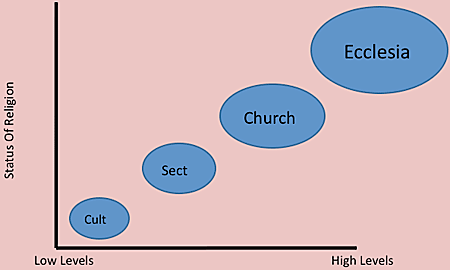
© 2009 Ron J. Hammond, Ph.D.
One final concept should be discussed. Secularization is the trend toward worldly concerns and away from concerns for the religiously sacred in the lives of society's members. Another study of US religiosity was collected over three scientific surveys conducted in 1990, 2001, and again in 2008 (The American Religious Identification Survey was taken from the Internet on 9 March 2009 http://www.americanreligionsurvey-aris.org/ ). Data indicated an increase in the percentage of those in the US claiming no religion from 8.2 percent 1990, to 14.2 percent 2001, and finally 15 percent in 2008. The US is becoming more and more secular. Typically the more modern a society becomes the less religious it remains and the more secular it becomes. There exist an inverse (opposite) correlation between science, modernization, rationality and religious traditions and adherences (see http://www.adherents.com/).
If you find the scientific study of religion to be interesting you might consider some of the WebPages below:
- The Association of Religion Data Archives at http://www.thearda.com/
- SSSR Society for the Scientific Study of Religion at http://www.sssrweb.org/
- ASR Association for the Sociology of Religion at http://www.sociologyofreligion.com/
- Greek Orthodox Archdiocese of America at http://www.goarch.org/
- The Website of The Bah‡'’ Faith http://www.bahai.org/
- American Atheists at http://www.atheists.org/
- Rastafarian.net at www.rastafarian.net/
- Association of Statisticians of American Religious Bodies at http://www.asarb.org/
- The Yearbook of American and Canadian Churches at http://www.electronicchurch.org/
- The National Council of Churches at www.ncccusa.org/
- Beliefnet.com http://www.beliefnet.com/
- American Buddhist at http://www.americanbuddhist.net/
- American and World Sikhs at http://www.worldsikhcouncil.org/
- American Hindu net at http://www.hindunet.org/anti_defamation/
- American Jewish History at www.350th.org/ or http://www.ajhs.org/
- Black American Jews at www.blackandjewish.com/bajpages/bajindex.html
- The Anglican Communion at http://www.anglicancommunion.org/
- The Southern Poverty Law Center teaching Tolerance at www.splcenter.org/center/tt/teach.jsp
- The American Muslim at http://www.theamericanmuslim.org/
- Muslim American Society at www.masnet.org/
- The American Catholic Church in the United States at http://www.accus.us/
- The Church of Jesus Christ of Latter-day Saints (Mormons) at http://www.lds.org/ldsorg/v/index.js...001f5e340aRCRD
- The Southern Baptist Convention at www.sbc.net/
- The American Association of Lutheran Churches at http://www.taalc.org/
- The African Methodist Episcopal Zion Church at http://www.amez.org/news/index.php
- National Baptist Convention of America Inc. at www.nbca-inc.com/


